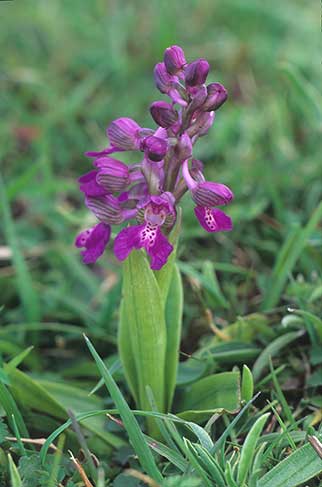Green-winged orchid (Orchis morio)
When: April - May
How many: Locally distributed and quite scarce

The green-winged orchid is an attractive little plant that in the New Forest is very locally distributed and not particularly abundant.
Green-winged orchids prefers neutral or calcareous soils rather than the primarily acid soils of the New Forest, where those that do occur tend to be relatively small. Elsewhere in Hampshire, green-winged orchids are typically found in old pastures and gravel pits; on dry, chalk-based grasslands; in damper, clay meadows; and sand dunes.
Somewhat confusingly, the green-winged orchid is still occasionally referred to as the green-veined orchid. They are, though, one-and-the-same plant.
Until the mid-1950s, green-winged orchids were relatively common and widespread in much of Britain, but now are regarded as nationally threatened, a victim of habitat loss largely associated with agricultural intensification.
They flower quite early – in April and May – and in Hampshire and elsewhere, were known as cuckoo-flowers as they appeared at around the time the first cuckoo’s call was heard.
Green-winged Orchids are distinctive plants with blooms that vary in colour from reddish-purple, through pink to whitish. Flowers are always towards the top of the stem, in a short, loose cluster. The lower lip has purplish spots, is shallowly 3-lobed, and strongly folded, whilst the hood is prominently green-veined.
The leaves, mainly in a rosette at the base of the stem, are spear-shaped, pointed and unspotted.
As with many members of the orchid family, the green-winged orchid's testicle-like tubers inevitably resulted in herbalists of old using them as aphrodisiacs, with countless numbers dug for this purpose well before modern agriculturalists set to work and far more effectively reduced the numbers.
References:
The Flora of Hampshire: Anne Brewis, Paul Bowman and Francis Rose
Wild Orchids of Hampshire and the Isle of Wight: Martin N. Jenkinson
The New Forest – A Natural History: Colin R. Tubbs
The Encyclopedia of British Wild Flowers: John Akeroyd
The Englishman’s Flora: Geoffrey Grigson
More links
Other related links
Search this site

Sadly, 58 animals were killed - 35 ponies, 13 cows, 8 donkeys and 2 sheep, whilst a further 32 were injured - 3 pigs, 9 donkeys, 11 cows and 9 ponies.
(Forty-three accidents occurred in daylight, 15 at twilight and 101 in the dark. Twenty-seven accidents were not reported by the driver involved).
Here's just one horrific example - Three donkeys killed in collision with van at notorious New Forest blackspot (Advertiser and Times)

